By Simon and Sally Currin,
Cruising Club of America Boston Station
Shimshal arrived in Labrador in 2018, and our intention was to continue to the western Caribbean and New Zealand the following year, but as all sailors know, plans frequently change. The scenery and the Newfie welcome detained us for a season, and when we eventually crossed the Cabot Strait in 2019, we fell in love with Cape Breton and decided to linger. A head-on encounter with Hurricane Dorian didn’t deter us, and we found Shimshal a winter home in Mahone Bay, Nova Scotia, where she stayed for the duration of the pandemic.
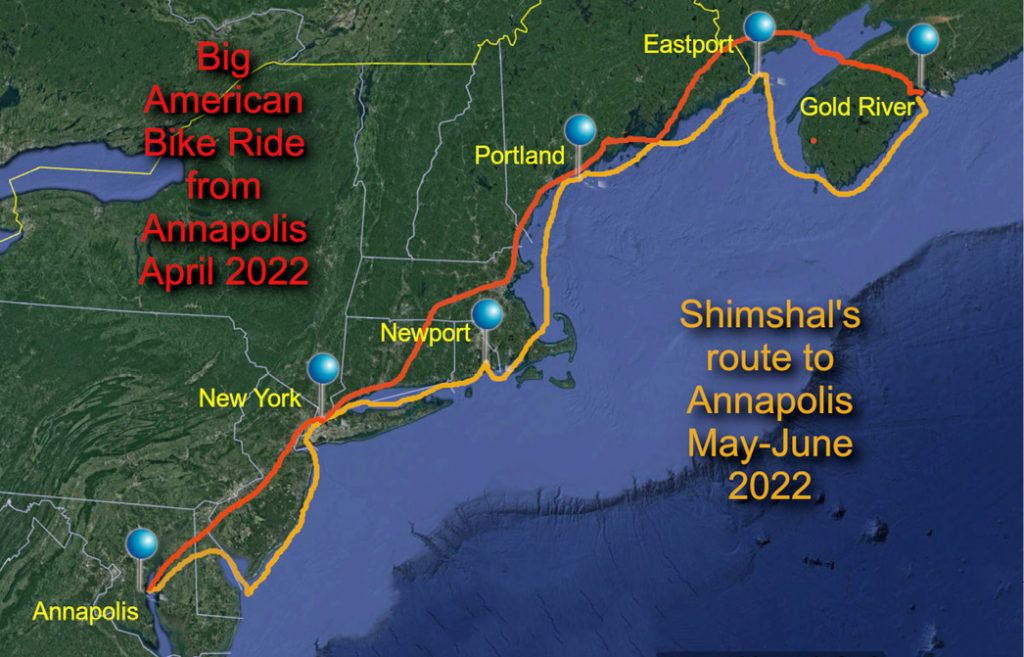
Sally & Simon’s routes by bike and boat
Finally, in the spring of 2022, we were able to resume our passage south. We were itching to get underway as early as possible, but Darrin, the Gold River Marina manager, advised against an April launch and was dubious about a May one too. Snow, powerful northeasterlies, and lobster pots apparently make early-season cruising nightmarish in Nova Scotia. We compromised and booked our launch for May 7, 2022.
We then faced a conundrum. As the commodore of the Ocean Cruising Club (OCC), I was up for re-election and had to be in Annapolis in early April for the annual general meeting. As we are based in the United Kingdom, we didn’t want to be making repeated transatlantic flights for financial and environmental reasons. We needed a slow way to travel from Annapolis to Nova Scotia during the month of April to retrieve our boat. I knew we could easily average 50 miles a day on our bicycles, and a long bike ride through New England and the Canadian Maritimes was feasible. Once back in Canada, we could dismantle and stow our bikes on board Shimshal and sail back to Annapolis. Furthermore, we could use the bike and boat trip to acquaint ourselves with our burgeoning contact list that has emerged from our OCC and CCA memberships.
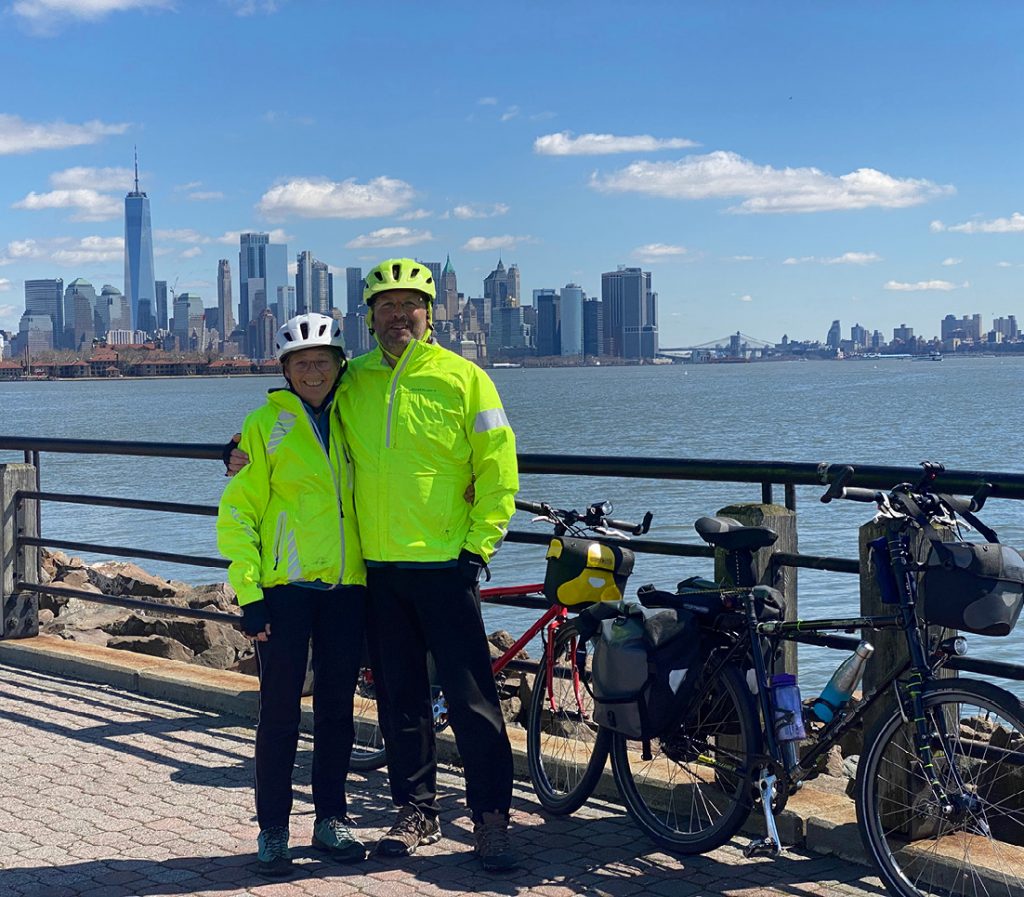
Liberty Park
Sally is more pragmatic than me and immediately focused on the flaws in the plan. We had been warned about boisterous and frigid northeasterlies in April. Could we pedal against such strong headwinds? Where would we stay? How would we cope with city traffic, crime and cold, and what would happen if we ran out of puff?
Slowly a plan came together once we discovered the East Coast Greenway, which is a fledgling cycle route running from Key West, Florida, to Calais, Maine. Its halfway point is Annapolis, which meant that we could jump on our bikes immediately after the OCC meeting and ride it the whole way north to Canada. We knew that we could then take the ferry across the Bay of Fundy from Saint John, New Brunswick, to Digby, Nova Scotia.
The East Coast Greenway is still being developed but aims to link bike tracks on disused railways, purpose-built cycle trails, and roads with bike lanes along its 2,000-mile course. We joined a charitable organization called Warmshowers whose members, all of whom are cyclists, offer free accommodation to those arriving on two pedal-powered wheels. That would take care of some of our needs.

Bikes and boat reunited in Mahone Bay, Nova Scotia
The most enchanting benefit of being OCC commodore is the ongoing email dialogue I have with the 3,409 members scattered around the globe. Some 40 percent of OCC members are from the U.S. and most of those live between Chesapeake and Nova Scotia. The next step in our planning was to write to the OCC membership informing them of our hare-brained plan and see if any of them might take us in along the way. I pressed “send” to the email with some trepidation as I had no idea how it would be received. Within minutes, generous offers of beds, suppers, and showers flooded in, just as would be expected from the cruising community. Some members wanted to cycle part of the way with us, others were keen to gather other cruisers together for a gam along our way. The response was overwhelming, but having gone public with our little plan, we were now committed!
A couple months later, we maneuvered bags filled with boat bits and two bicycles through a frenetic Manchester, U.K., airport bound for the annual meeting and dinner in the graceful setting of the Annapolis Yacht Club. As soon as the formalities were over, we swapped posh clothes for cycle attire and filled up John van S’s suitcases with “essential” boat bits that he then flew home with and would return to us in Halifax a month later. The cruising community’s resourcefulness and willingness were now becoming mind-boggling!
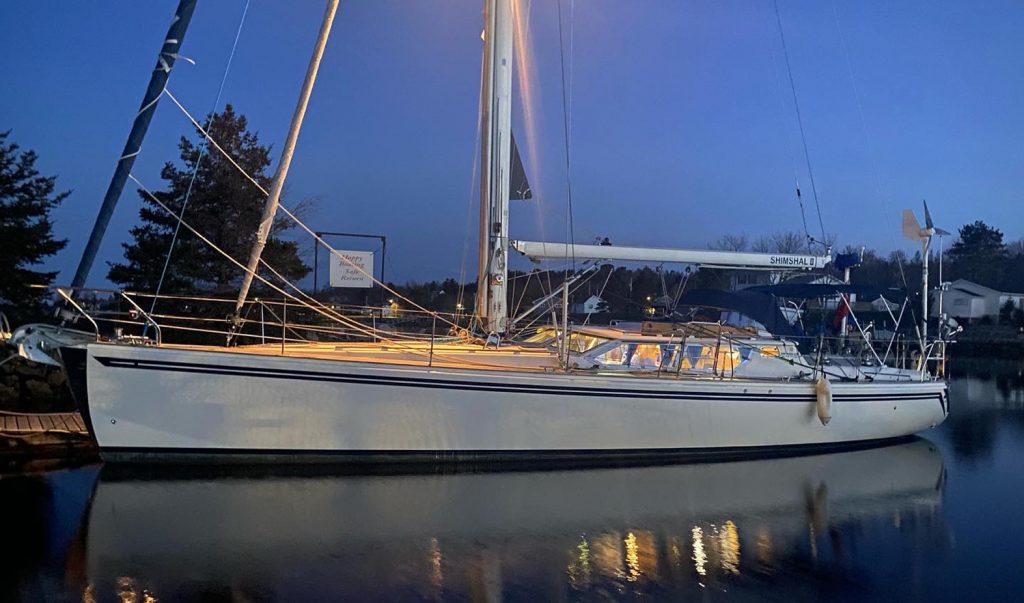
Shimshal shortly before departing Nova Scotia
What we hadn’t bargained on was COVID. In late February we both came down with Omicron, having managed to avoid it whilst working on the frontline of Britain’s National Health Service. Though neither of us was very ill, Sally had a longer recovery and in early April was still functioning on fewer cylinders than normal. Not a great start to a month-long bike ride. COVID too struck some of the households we planned to visit along the way, forcing late changes of plan.
Once in the saddle and pedaling along the disused Annapolis-to-Baltimore railway, Sally’s energy returned, and her recovery was complete. In Baltimore, we took the bikes in the elevator to the seventh floor of the Comfort Inn when disaster struck. Sally is a numbers person and loves to monitor speed, miles, and much more. Her beloved bicycle computer fell from the handlebars and found the crack between lift and door that led to the shaft. We never saw the computer again, but having been robbed of her data Sally was freed to concentrate on Baltimore’s rush-hour traffic and the cherry blossom-lined roads.
Biking through Baltimore was not a great introduction to the East Coast Greenway, and crossing the bridge over the Susquehanna River was the most terrifying. There’s no bike lane, and the concrete walls constrain and concentrate the noise of the massive trucks as they thunder past. We were glad to arrive in Delaware and took selfies at every state border after that.
Our first northeasterlies hit us in Wilmington with driving rain and frigid gusts.
We tried desperately to hire a car to skip a few miles, but COVID had demolished the car rental business and no vehicles were available. Soaked to the skin, it was with great relief that we discovered the Joe Biden Railway Station [God help us – Ed.] and boarded the Amtrak service for two stops to shorten our route and maintain our schedule whilst the gale blew through.
Clear blue skies and freezing temperatures followed the passage of the front, giving us perfect cycling conditions for our long ride through New Jersey to the Goethals Bridge, where we got our first-ever glimpse of the Manhattan skyline glinting in the morning sun. We hurried on through docks, factories and endless warehouses to the Bayonne Bridge and another, nearer, view of skyscrapers. Then came a ride around Liberty Park and more selfies before pedaling past the slips of the Liberty Park Marina, trying in vain to spy CCA and OCC burgees.
We had fretted about New York traffic, but the city has embraced cyclists and spent a fortune keeping bikes and cars apart. From the Staten Island Ferry at Battery Park, we joined the crowds of scooters, skaters, bikers, and joggers on the purpose-built road that hugs the shoreline of the Hudson River northbound before cutting east to Central Park. A one-way system in the park allowed us to safely navigate to our first Warmshowers destination in Harlem, where a keen cycling couple shared their home and swapped long distance cycling stories — just as cruisers do.
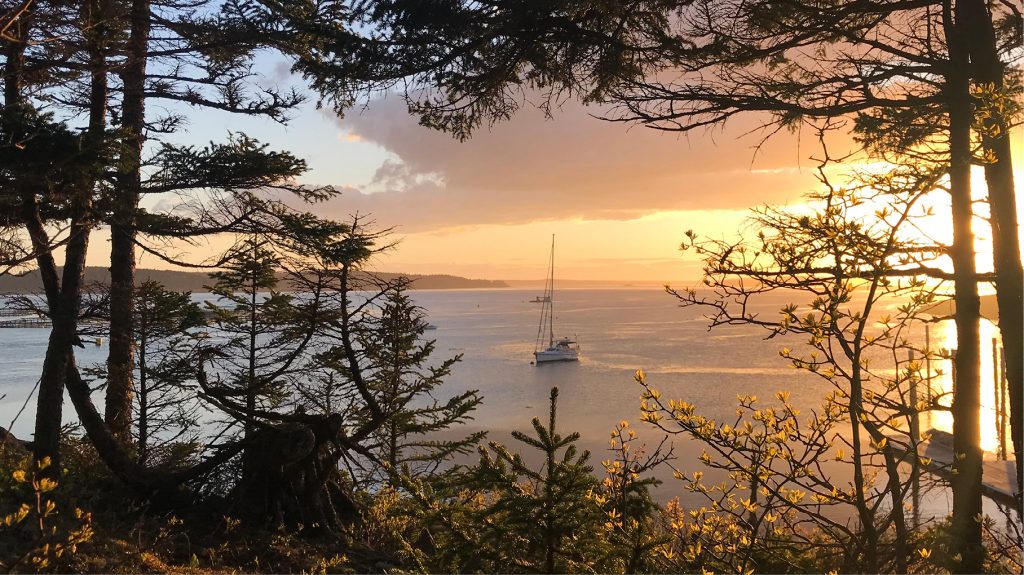
Anchored near Eastport, Maine after checking in to the U.S.
That night a Sherpa friend from Nepal picked us up in his taxi and swept us off to Queens for a meal of momos in his favourite Tibetan restaurant. Tenji, whom we had last seen in the Himalayas, had emigrated and built a new life for his family in the hustle and bustle of New York.
The suburbs of New York seemed to go on forever, but gradually they gave way to Connecticut mansions with white picket fences, manicured lawns, and plumes of yellow forsythia promising the arrival of spring. In Stamford, David Tunick was one of the CCA members who gave us the full cruiser welcome before we pedaled on to Norwalk for a rendezvous with legendary double circumnavigators Scott and Kitty Kuhner.
At New Haven, our route took us inland through Yale and then along the course of a filled-in canal that linked with the disused Airline Railway between New York and Boston. Gorgeous cycling through rural Connecticut with overnights in Hartford and Putnam before the old train line led us into the heart of Boston and a lunch with CCA members at Ernie Godshalk’s city centre apartment.
We re-joined the coast north of Marblehead, where we had to cancel a planned rendezvous because our host had come down with COVID. More selfies on the New Hampshire and Maine borders and then another northeasterly enforced a rest day at a beachside motel in Ogunquit.
The hospitality of Maine cruisers is a legend on this side of the Atlantic, and we weren’t disappointed in Portland and Boothbay, where warm beds restored us after cold days in the saddle. Most days we were fuelled by Dunkin Donuts, but for some reason, we chose to forgo a calorific detour in Thomaston and instead pedaled past the boatyard where we were confronted by a boat we knew well when we sailed on her to the Antarctic in 2006. Pelagic, Skip Novak’s aging Southern Ocean workhorse, was hauled out and having a substantial refit in Maine.
As we neared Camden, texts started pinging in from Doug and Dale Bruce, who were anxious for us to avoid pedaling up their long hill to their lovely house on Bald Mountain. At the dock, my odometer clicked 850 miles pedaled from Annapolis, and we took a celebratory selfie before the Bruce truck arrived and bundled our bikes in the back for the 1,000- foot ascent to luxury, gams, rest, and respite from yet another cold northeasterly.
We liked it so much at the Bruces that we stayed for five days, which blew a hole in our schedule, but Doug and Dale had a plan. The truck was loaded with the bikes again, and a few hours later we waved our farewells to our hosts at the Canadian border where the snow was blowing horizontally, and the cherry blossoms of Maryland seemed like a century ago. We had outrun the spring and were now in the lingering Canadian winter with yet more weather on the way.
In Saint John, New Brunswick, the CCA’s rear commodore, Ernest Hamilton, politely suggested a motel upgrade as he didn’t think the one that we had booked was suitable for gullible Brits on bikes. Having rescued us from our own thrift, he bundled us into his wonderful old Lincoln for a fascinating tour of Saint John and its yacht clubs.
When we finally got to Halifax, we were royally entertained by John and Heather van S who reunited us with the “essential” boat kit that he had flown home with. John had arranged a dinner at the Royal Nova Scotia Yacht Squadron, and he presented us with a framed photo he had taken of us with our bikes a month earlier when he waved us off in Annapolis. Now we are owners of a John van S original photo, which is certainly worth pedaling 850 miles!
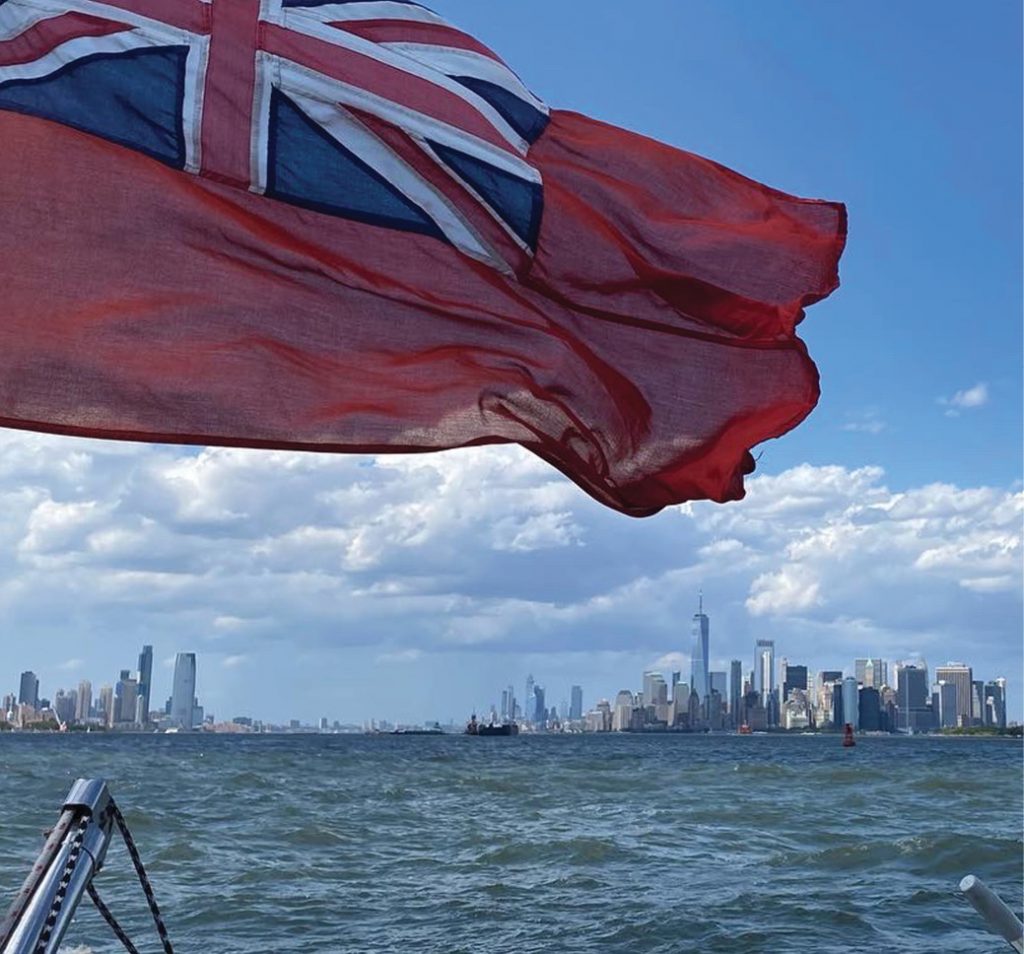
Sailing south
Our boat was soon launched in Mahone Bay, and yes, we should have heeded the warnings about Nova Scotian sailing before the lobster season ends on May 31. Our keel caught three pot lines rounding Cape Sable because of the curious practice of allowing 100 feet of floating line to stream in the strong currents around the cape. And it was cold sailing so early in the season, but we were privileged to have the glorious coast of Maine to ourselves with little fog and few pots once we left Nova Scotia in our wake.
Our sailing cruise back to Annapolis took us down Long Island Sound, New York’s East River, and finally through the C&D Canal and a late June haul-out and flight home (with bikes) to escape the gathering Chesapeake heat.
Looping our way around New England by bike and boat enabled us to get to know North America’s cruisers both in their homes and on their boats and gave us a great workout along the way. ■
Recent retirees Sally and Simon spend half their time cruising aboard Shimshal and the rest of the year dabbling in land-based adventures, mainly in Europe. Since 2018 they have been meandering down the coasts of Labrador, Newfoundland, Nova Scotia, and New England. They are currently bound for Panama and the Pacific. They joined the CCA in 2020 and are delighted with the warm reception they’ve received from members during their time cycling and sailing in North America.
With thanks to the Cruising Club of America in whose magazine, Voyages Issue 65, this article first appeared, and Voyages editors Amelia & Robert Green.
The Cruising Club of America (CCA) is a collection of 1,400 ocean sailors with extensive offshore seamanship, command experience, and a shared passion for making adventurous use of the seas. Their experiences and expertise make them, collectively, one of the most reliable sources of information on offshore sailing. Visit cruisingclub.org to learn more.




